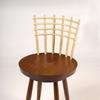Counting the Hours: Art, Data and the Untold Stories of Women's Work
- SAN FRANCISCO, California
- /
- September 17, 2019
A new art exhibition by Sawyer Rose and The Carrying Stones Project, puts women's (paid and unpaid) work into sculptural form based on data. On view at Code & Canvas, San Francisco, September 19 through November 2, 2019.
You’ve been offered a part-time job. Your responsibilities will be uninspiring and tiresome: scrubbing toilets, changing diapers, that sort of thing. You may also be asked to tackle some more advanced tasks like explaining algebra homework or providing skilled nursing care. And, the laundry bin is overflowing, so if you could get to that, that would be great.
I should probably mention that you won’t be getting paid for any of this work, so you should definitely keep your day job, if you have one. Will you take this new position? If you’re a woman, your answer is probably yes. Statistically, in the U.S., women average more than four hours of unpaid labor in their homes and their communities each day. U.S. men, though, are only clocking a little more than half that amount.
Counting the Hours, a new exhibition from San Francisco-based artist Sawyer Rose and The Carrying Stones Project, shines a light on the systemic and pervasive inequalities that working women face, including the physical, emotional, and practical effects of these disproportionate labor loads. The artworks in this show portray the deeply personal work stories of a diverse group of women and are accompanied by the data that tells a bigger story. The women profiled are a mix of ages, ethnicities, sexual orientations, occupations, and socio-economic statuses.
Rose uses a unique combination of art and science to communicate her findings about women’s work. Her large-scale installation sculptures in Counting the Hours are built using real-life work data collected from female-identifying workers from all walks of life and from across the U.S. Participants record their work hours, paid and unpaid. Then, Rose translates each subject’s hours into a data visualization sculpture that helps viewers better understand the vast number of hours each woman logs at her paid job and at her un-paid home or volunteer job.
Once a woman’s data sculpture is complete, Rose takes the storytelling a step further by taking a photographic portrait of each woman lifting and carrying her sculpture, bearing the burden of her hours in a real and physical way.
One subject, Loeta Robles, who is Peruvian American, drove back and forth from Chico, California, to San Francisco for years while earning her dental degree. While she was away during the week she would keep up with everything at home via Facetime, even "attending" family dinner night with her Peruvian-American parents and brother and helping her kids with their homework. Saturday morning she'd leave the city at 3:30am, returning home on time to make it to the kids' soccer games and 4-H events.
Another subject is Renée Stout, herself a sculptor and contemporary artist. Even with success in her field, she still struggles with keeping up with her paid work plus all the unpaid tasks required to run her business and her life. On the average women visual artists earn 74¢ for every dollar made by male artists, and black women working in all fields earn on average 65¢ for every dollar made by white men.
The + sign is an hour that Renee did paid labor. Sawyer Rose adapted the motif from a cross sign that Renee uses often in her own art work. Each wooden box with a + on it equals one paid labor hour that Renée reported to Sawyer. Renee’s unpaid labor hours (as can be seen in her portrait) are wire frame boxes – – less visible and less weighty, as women’s unpaid labor is accorded less status and importance (and money) in society.
The Counting the Hours exhibition also features a new series of wall works that uses data visualization to help explain some of the most hotly debated current labor issues: the gender pay gap, unequal representation of women in leadership positions, and the “double burden” of women in the workforce who are also caregivers.
On Saturday and Sunday, October 26 and 27, the exhibition will host a weekend-long public participation event at which visitors can add their own work/hour data to a community-produced data visualization tapestry.
“The strong, working woman is a force of nature and too often her efforts are underpaid and underappreciated,” Rose says. “The stories in Counting the Hours may not represent your life or your particular situation, but they definitely depict the lives of many women you know and love, women who work with you or for you,” she says. “The good news, though, is that everyone can reap the benefits of a gender-equitable workforce: increased Gross Domestic Product (GDP), more profitable businesses, and healthier, happier partners and children.”
Counting the Hours is on display from September 19 through November 2, 2019 at Code & Canvas, 151 Potrero Ave., San Francisco. It is produced by The Carrying Stones Project, a nonprofit that provides public education about women’s work inequities in their many forms. The opening reception takes place from 6-9 p.m. on Thursday, September 19, 2019.
Exhibition hours are Tuesdays and Thursdays from 1 p.m. to 6 p.m., Saturdays from 12 p.m. to 3 p.m., or by appointment.
Counting the Hours Exhibition Hours
September 19 through November 2, 2019
Code & Canvas
151 Potrero Ave., San Francisco 94103
Tues. & Thurs. from 1-6 p.m.
Sat. from 12-3 p.m. and by appointment
Free admission
Programs (Note: Exhibit and event admission is free.)
Opening Reception
Thursday, September 19, 2019, 6-9 p.m.
At Code & Canvas, 151 Potrero Ave., San Francisco 94103
With performance by RAWdance at 7:30pm. The piece, choreographed by Co-Artistic Director Katie Wong, features a quartet of female movement artists and is inspired by the subjects, process and visual art works of Sawyer Rose’s Counting the Hours exhibition.
Free admission
Counting the Hours Public Participatory Event: Crafting Balance
During ArtSpan Open Studios Weekend 3
Saturday and Sunday, October 26 & 27, 2019, 11 a.m. – 6 p.m.
At Code & Canvas, 151 Potrero Ave., San Francisco 94103
Visitors to the exhibition can weave their own work data into a community-created data visualization tapestry.
Free admission
Closing Reception
Saturday, November 2, 2019, 6-9 p.m.
At Code & Canvas, 151 Potrero Ave., San Francisco 94103
Free admission
About The Carrying Stones Project
The Carrying Stones Project, a fiscally sponsored nonprofit, uses large-scale sculpture, data visualization artwork, and social practice events to explore women’s work inequity in its many forms. The works presented by the project are distilled from the personal narratives of women of diverse ages, ethnicities, orientations, working roles, and socio-economic statuses.
For more information: https://www.carrying-stones.com







100x100_c.jpg)





